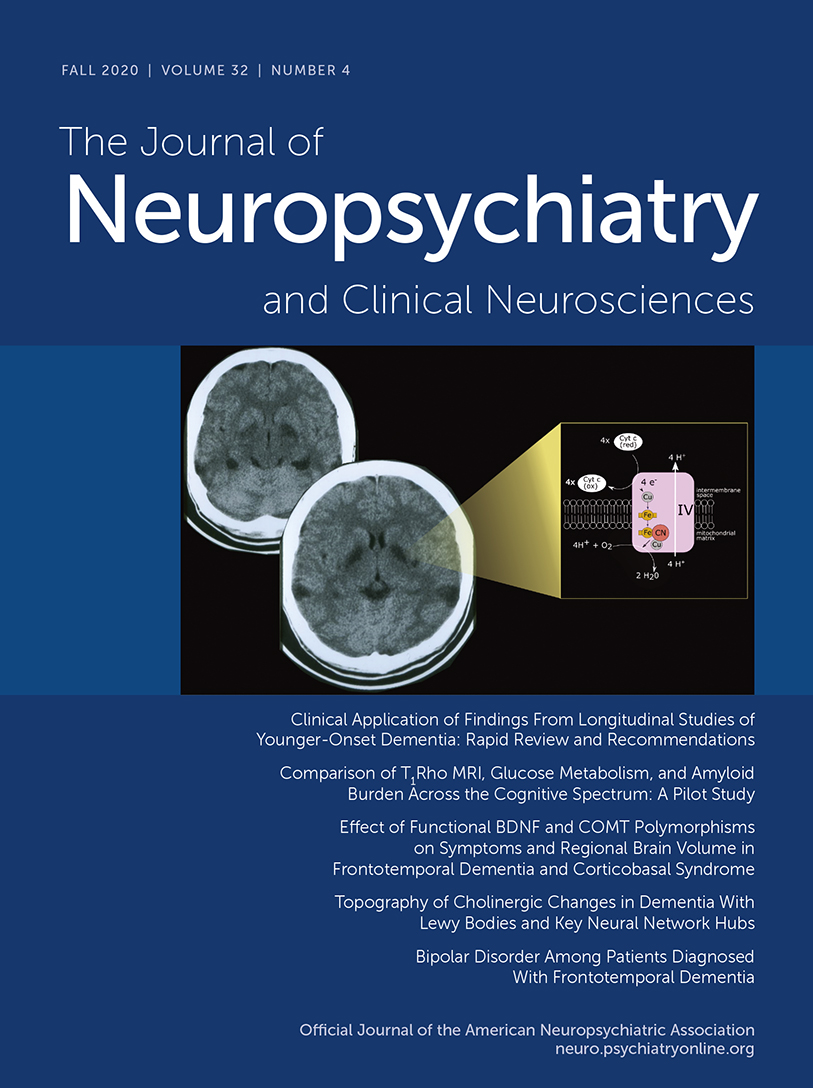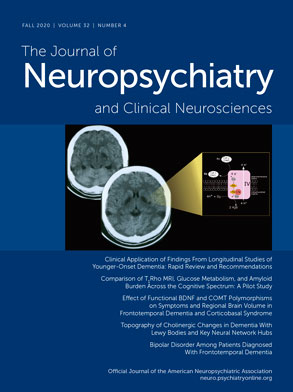Bipolar Disorder Among Patients Diagnosed With Frontotemporal Dementia
Abstract
Objective:
Methods:
Results:
Conclusions:
Methods
Participants
Procedures
Results
Prodromal Group
| Patient (gender) | Mania/hypomania | Psychiatric symptoms age at onset (years) | bvFTD criteria | bvFTD age at onset (years) | Family psychiatric history | FDG-PET imaginga |
|---|---|---|---|---|---|---|
| 1 (female) | No: suicidal, paranoia | 25 | Yes: probable | 34 | Yes: depression, suicidal | Right frontal, bitemporal |
| 2 (female) | Yes: mania plus psychosis, depression | 37 for depression, 40 for mania | Yes: probable | 48 | Yes: suicidal | Bifrontal (worse on the left side) |
| 3 (male) | No: suicidal, impulsive | 58 | Yes: probable | 58 | Unknown | Bitemporal |
| 4 (male) | Yes: treated depression followed by persistent mania | 33 (cyclothymia 20s) | Yes: definiteb | 45 | Yes: depression, suicidal | Bifrontal |
| 5 (male) | Yes: hypomania, depression | 42 | Yes: possible | 48 | Yes: depression | Unavailable |
| 6 (male) | Yes: mania and depression | 56 (ECT)c | Yes: probable | 68 | Family lost in war and history unavailable | Bitemporal > bifrontal |
| 7 (male) | Yes: mania plus psychosis | 61 | No | 61 | No | Mild parietal |
| 8 (male) | Yes: mania plus psychosis every 4- to 6-month cycle | 63 | Yes: probable | 70 | Yes: depression, C9orf72 | Bitemporal |
| 9 (male) | Yes: mania plus psychosis | 34 | Yes: probable | 44 | Yes: depression | Bifrontal, bitemporal |
| 10 (male) | No: antisocial, obsessive-compulsive disorder | 31 | Yes: probable | 57 | Yes: depression | Bitemporal |
| 11 (female) | Yes: hypomania, depression | Approximately 59 | Yes: probable | 69 | Yes: depression, bipolar disorder | Bitemporal |
| 12 (male) | Yes: mania plus psychosis | 62 | Yes: definited | 66 | Yes: depression | Bitemporal > bifrontal |
| 13 (male) | Yes: severe mania | 60 | No | 60 | No | Mild temporo-parietal |
| 14 (female) | Yes: mania plus psychosis | 55 | No | 59 | No | Normal |
Phenotype Group
Additional Observations
Discussion
| Study | Objective | Patients and study methods | Results | Conclusions |
|---|---|---|---|---|
| Cerami et al. (72) | Investigating frontotemporal dementia with GRN mutation and preceding bipolar disorder symptoms | Two patients (males, N=2; age 57–60s) with GRN mutation | Both patients with years of preceding emotional dysregulation or dysphoric hypomania and depressive episode appearing in mid-life | Possible bipolar disorder prodrome phase preceding frontotemporal dementia |
| Dols et al. (47) | Investigating patients with bipolar disorder with late-life bvFTD mimic | Case report: bvFTD-like syndrome in four patients (males, N=4; ages 62–78) with long-standing bipolar disorder | Diagnosis of bipolar I disorder for ≥10 years; late apathy, disinhibition, loss of empathy and insight, repetitive behaviors, and mild executive dysfunction; nonprogressive for 3–7 years; normal imaging, nondiagnostic CSF, and negative C90rf72 | Nonprogressive bvFTD mimic in some patients with long-standing bipolar disorder |
| Floris et al. (71) | Investigating long-standing bipolar disorder preceding bvFTD with a C9orf72 mutation | Case report: recurrent manic symptoms (males, N=42), bipolar I disorder, and subsequent bvFTD with C9orf72 mutation | bvFTD found in patient 22 years (at age 64) after initially presenting with bipolar I disorder; examination revealing repeat expansions of C9orf72 (>70 repeats) | C9orf72 associated with phenotypic variability that may include bipolar disorder |
| Ibáñez, 2012 (8) | Investigating atypical presentation of bvFTD | Case report | A 44-year-old man with diagnosis of frontotemporal dementia via brain imaging with several years of preceding bipolar symptoms with psychosis | Bipolar disorder as potential prodrome of bvFTD |
| Kerstein et al. (9) | Investigating bvFTD mimicking bipolar disorder | Case report | A 65-year-old patient with close diagnostic criteria for bipolar disorder and frontotemporal dementia | bvFTD presenting as bipolar disorder |
| Lai et al. (46) | Comparing psychiatric disorders across dementia subtypes | Aggregated two national databases and estimated 2-year prevalence of mental health disorders across five dementia subtypes, including 1,181 patients with bvFTD | About 25% of patients with at least one mental health disorder, with a 2-year prevalence reaching 30%–45% in patients with frontotemporal dementia; frontotemporal dementia patients exhibiting the highest prevalence of mood (19%), anxiety (20%), and substance use (19%) disorders, as well as suicidal behavior (4%), compared with other subtypes | Mental health disorders (especially mood disorders) common among patients with bvFTD |
| Lebert et al. (50) | Characterizing dementia in patients with bipolar disorder | Thirteen patients with bipolar disorder (females, N=9; males, N=4); mean age=70.8 (SD=7.7); dementia with 6.1 years (SD=2.8) of follow-up | No criteria for bvFTD met; common executive dysfunction and frontal behavioral syndrome; moderate extrapyramidal symptoms in 10 patients; and functional imaging (10) revealing decreased frontotemporal uptake | May be a specific postbipolar dementia similar to bvFTD in several respects |
| Masouy et al. (49) | Proposing a potential link between bipolar disorder and dementia | Two patients (males, N=62; females, N=77), each with about 30 years of bipolar I disorder and late-life deterioration | Late cognitive deterioration during the euthymic phase with deficits in attention, verbal memory, executive functions, and behavior plus cerebral abnormalities on imaging | A “specific dementia” in bipolar disorder with similarities to frontotemporal dementia but with only mild worsening |
| Meisler et al. (70) | Investigating C9orf72 mutation in patients with bipolar disorder | Eighty-nine patients with bipolar disorder screened for C9orf72 | One male patient with bipolar disorder (1%) with C9orf72 expansion (14–20 kilobases) inherited from a parent (8.5–20 kilobases) with bipolar disorder who progressed to bvFTD | Possible association of C9orf72 with a form of bipolar disorder progressing to frontotemporal dementia |
| Monji et al. (10) | Investigating late-onset bipolar disorder with behavior and imaging similar to bvFTD | Case report | Patient with bipolar disorder misdiagnosed as bvFTD due to abnormal behaviors and neuroimaging observations | Possible presentation of bipolar disorder similar to bvFTD |
| Papazacharias et al. (18) | Investigating two patients with life-long bipolar disorder who developed frontotemporal dementia in later life | Case report: a 56-year-old woman with bipolar I disorder and a 53-year-old man with bipolar II disorder who developed signs and symptoms of FTD spectrum disorders | Declines in cognitive functions and behavioral and neurological signs consistent with frontotemporal dementia spectrum disorders; MRI and functional imaging changes in frontal and temporal areas | Risk for developing frontotemporal dementia before age 60 may be increased by life-long bipolar disorder |
| Pavlovic et al. (48) | Investigating lifetime bipolar disorder with late-life bvFTD | Case report: a 68-year-old woman with a 35-year history of bipolar I disorder who developed bvFTD | Patient meeting criteria for bvFTD with progressive deterioration, with frontal atrophy on CT and MRI and frontal-temporal hypoperfusion on single-photon emission computed tomography | Bipolar disorder may represent a preclinical phase preceding the onset of FTD |
| Rubino et al. (19) | Investigating late-onset bipolar disorder evolving into bvFTD in a patient with the GRN mutation | Case report: late-onset bipolar disorder (males, N=54) developing bvFTD (age 68 years old) with GRN mutation | Initial manic symptoms at age 54 progressing to bipolar disorder at age 55 followed by deterioration with apathy at age 68 and marked PET frontotemporal hypometabolism, with mutation in the GRN gene | Late-onset bipolar disorder that developed into bvFTD over time, carrying a mutation in the GRN gene |
| Vorspan et al. (25) | Investigating the association of manic episodes with bvFTD-like clinical changes | Case report: a 54-year-old woman with bipolar I disorder diagnosed with bvFTD during a manic episode but with neurocognitive improvement afterward | Subsequent relapses associated with cognitive deficits subsiding afterward, despite continued frontal hypoperfusion | Manic episodes may bring out clinical features of bvFTD |
| Woolley et al. (7) | Investigating rates for psychiatric diagnoses in patients with early neurodegenerative disease | Comparison of rates of psychiatric diagnoses (within 10 years) among patients with bvFTD (N=69), Alzheimer’s disease, semantic dementia, and other disorders | bvFTD patients with the most psychiatric diagnoses (50.7%), with eight patients (11.6%) having a diagnosis of bipolar disorder; rate increased by young age, education, and a family psychiatric history | bvFTD patients at high risk of being correctly or incorrectly diagnosed with a prior psychiatric disease |
Conclusions
References
Information & Authors
Information
Published In
History
Keywords
Authors
Competing Interests
Funding Information
Metrics & Citations
Metrics
Citations
Export Citations
If you have the appropriate software installed, you can download article citation data to the citation manager of your choice. Simply select your manager software from the list below and click Download.
For more information or tips please see 'Downloading to a citation manager' in the Help menu.
View Options
View options
PDF/EPUB
View PDF/EPUBLogin options
Already a subscriber? Access your subscription through your login credentials or your institution for full access to this article.
Personal login Institutional Login Open Athens loginNot a subscriber?
PsychiatryOnline subscription options offer access to the DSM-5-TR® library, books, journals, CME, and patient resources. This all-in-one virtual library provides psychiatrists and mental health professionals with key resources for diagnosis, treatment, research, and professional development.
Need more help? PsychiatryOnline Customer Service may be reached by emailing [email protected] or by calling 800-368-5777 (in the U.S.) or 703-907-7322 (outside the U.S.).

